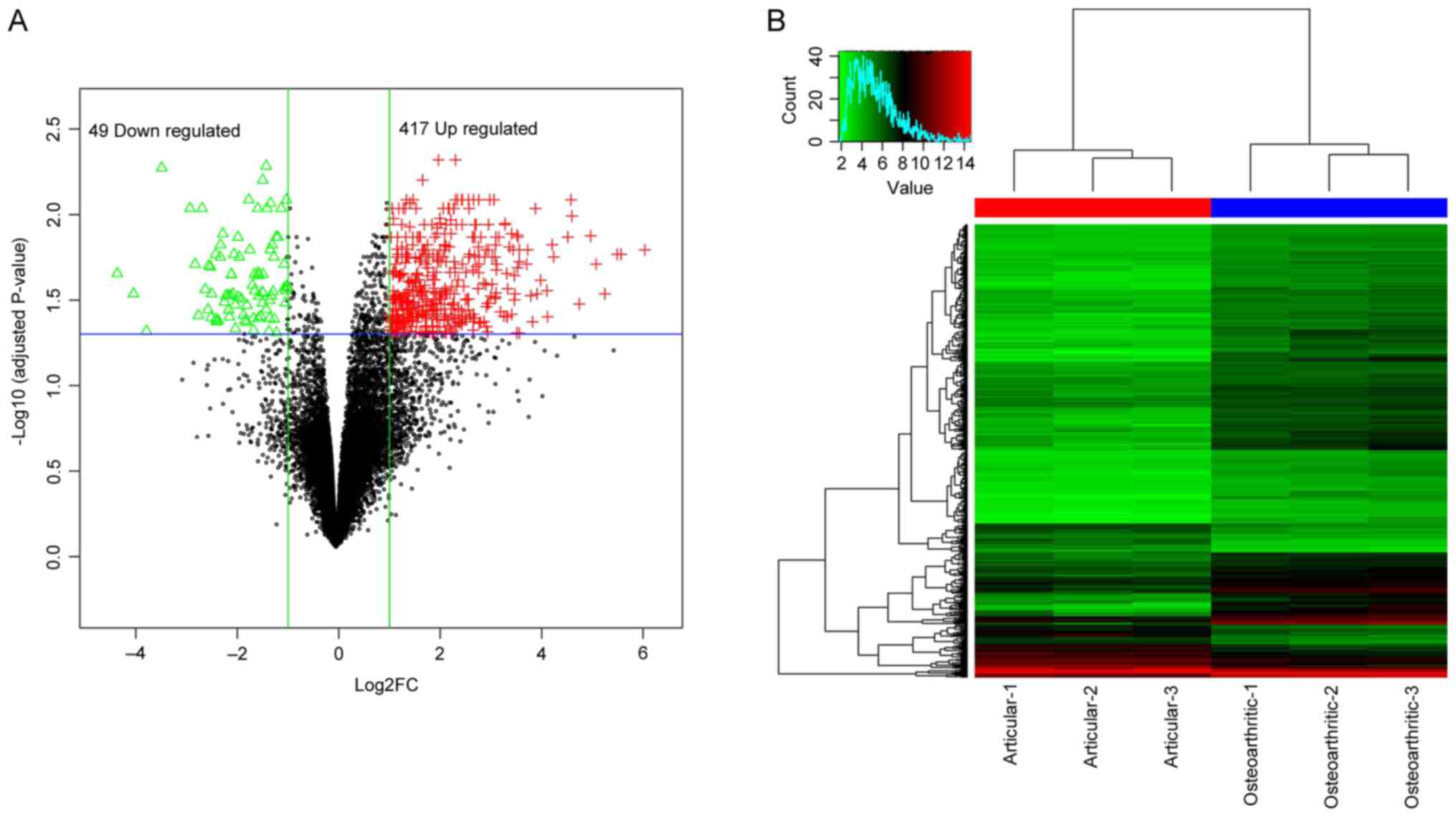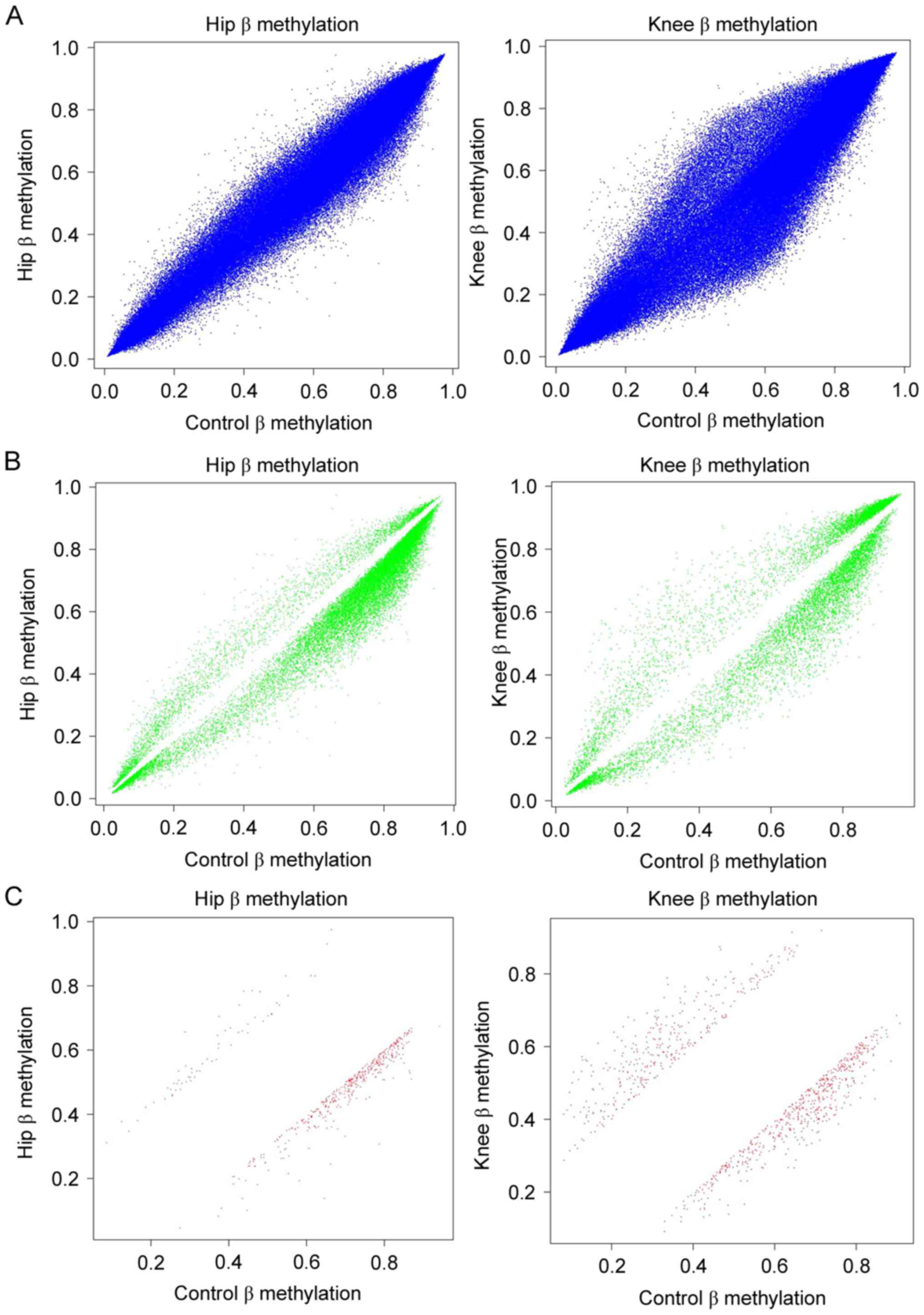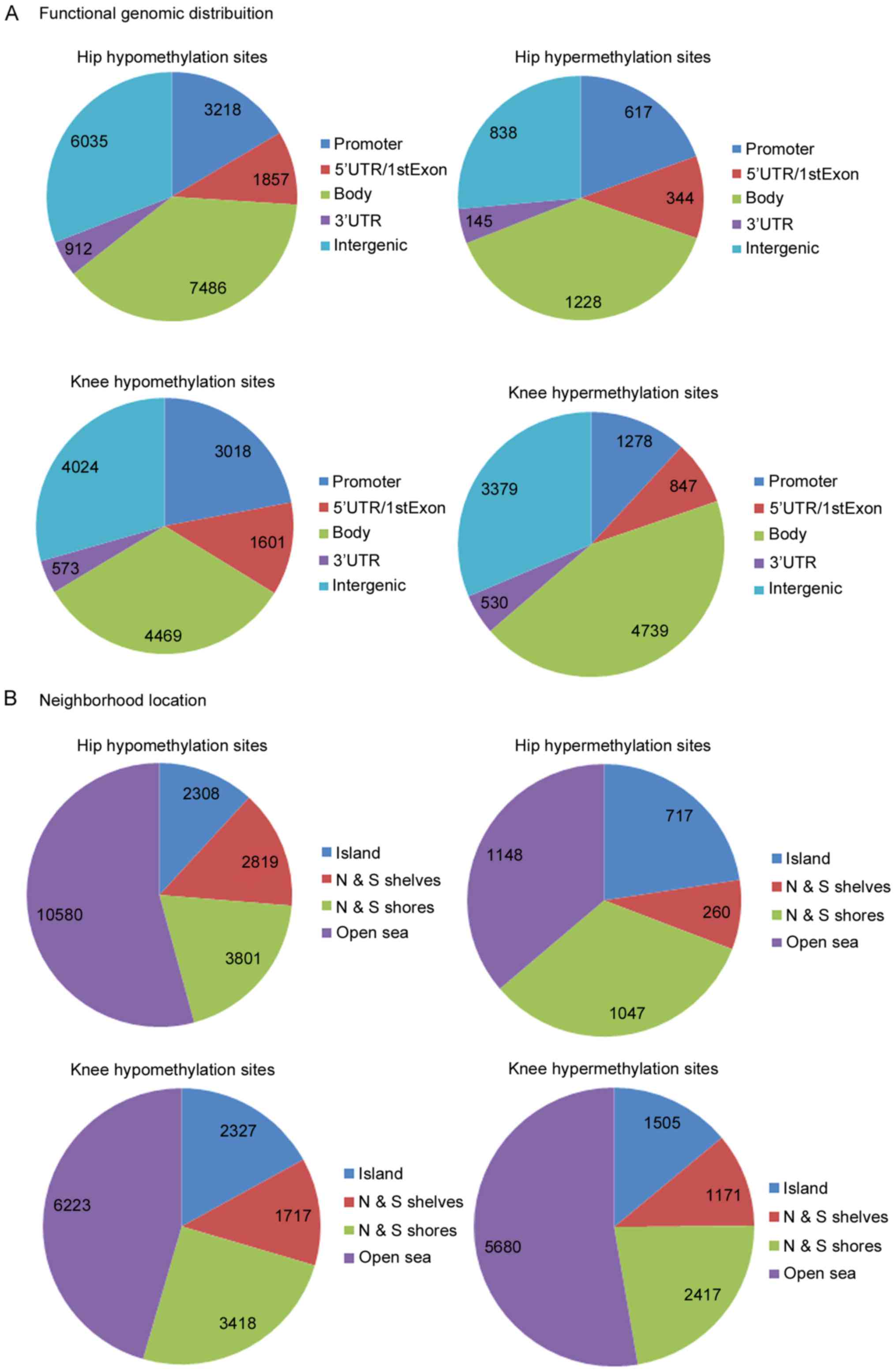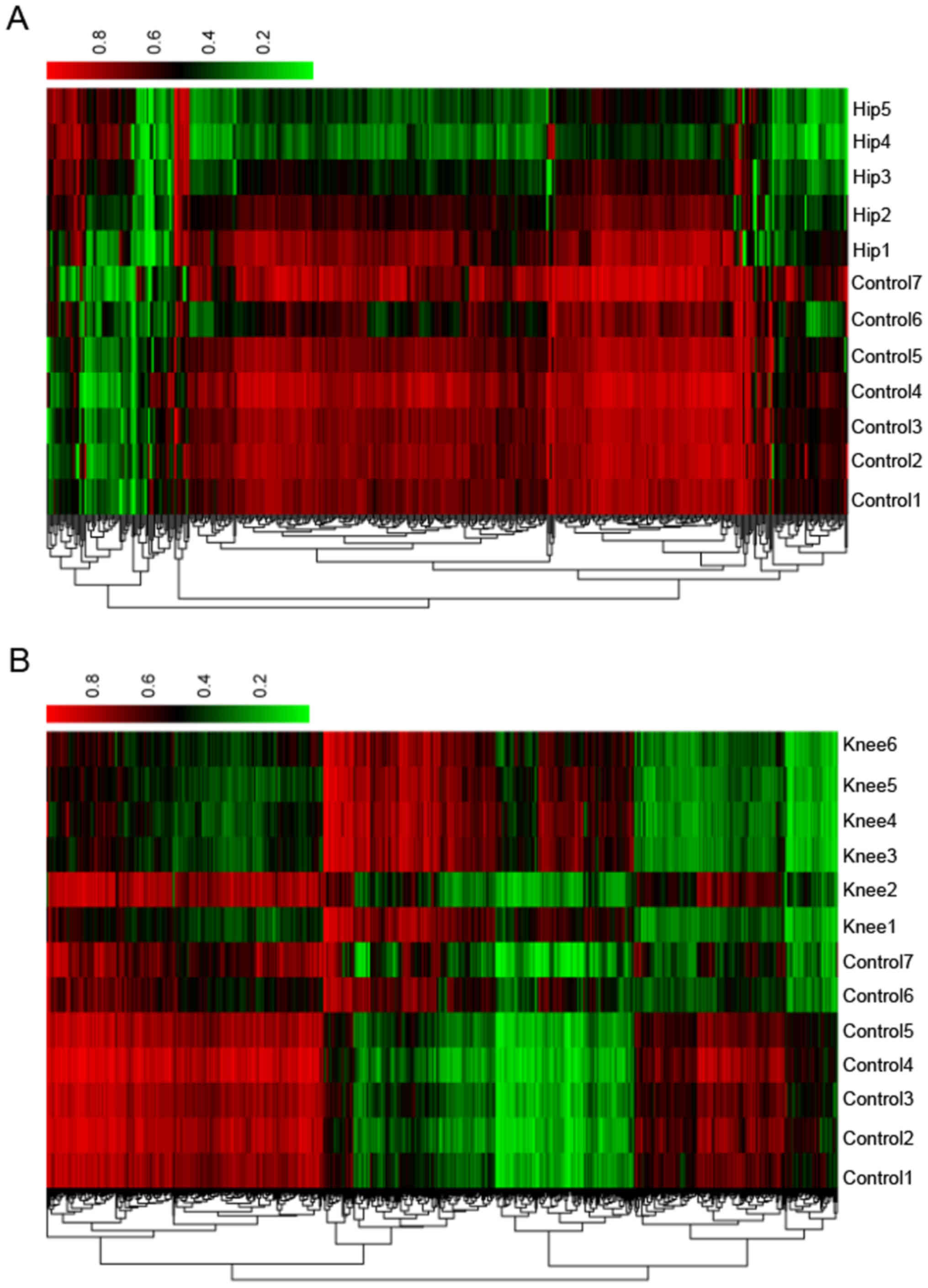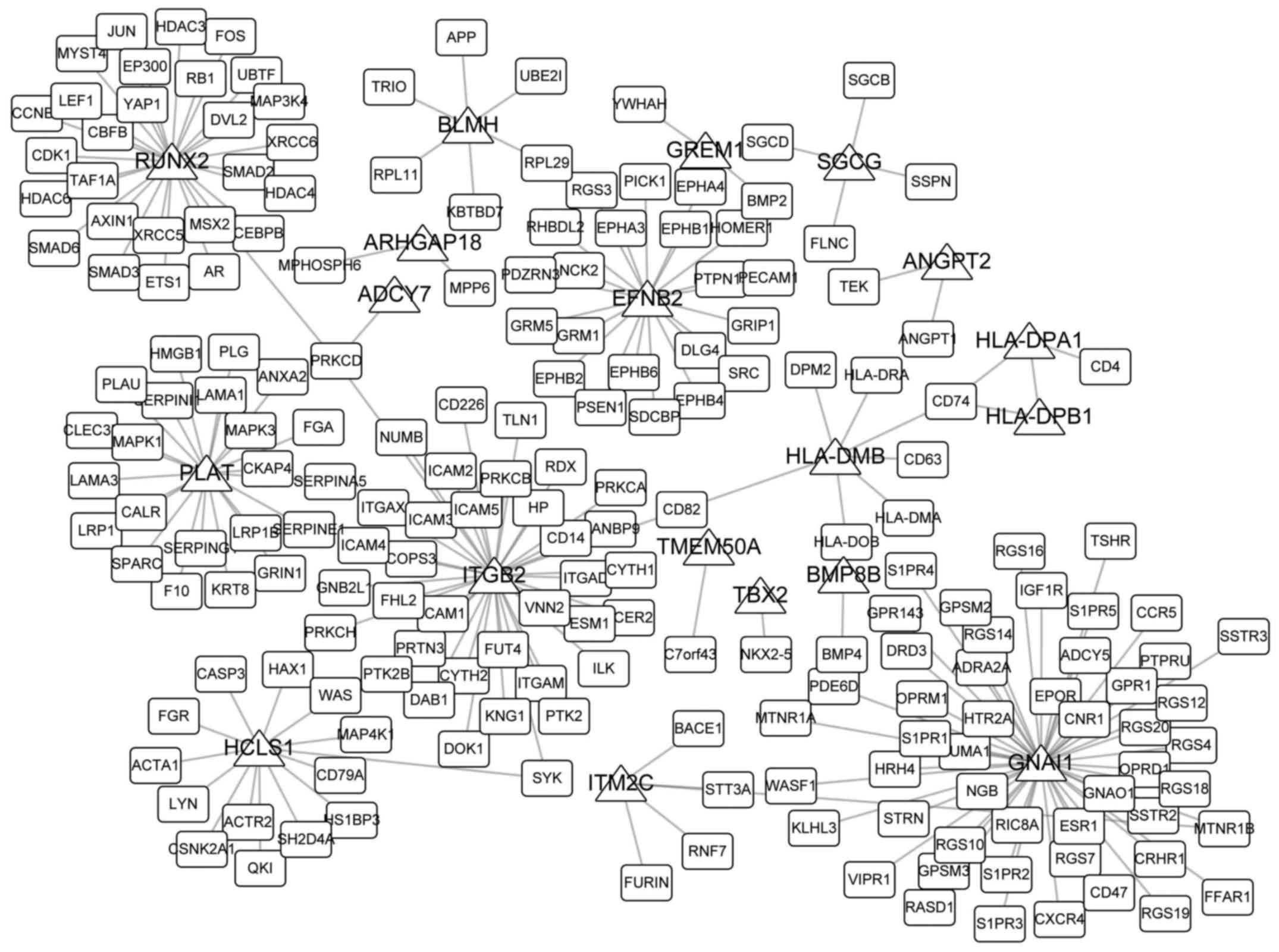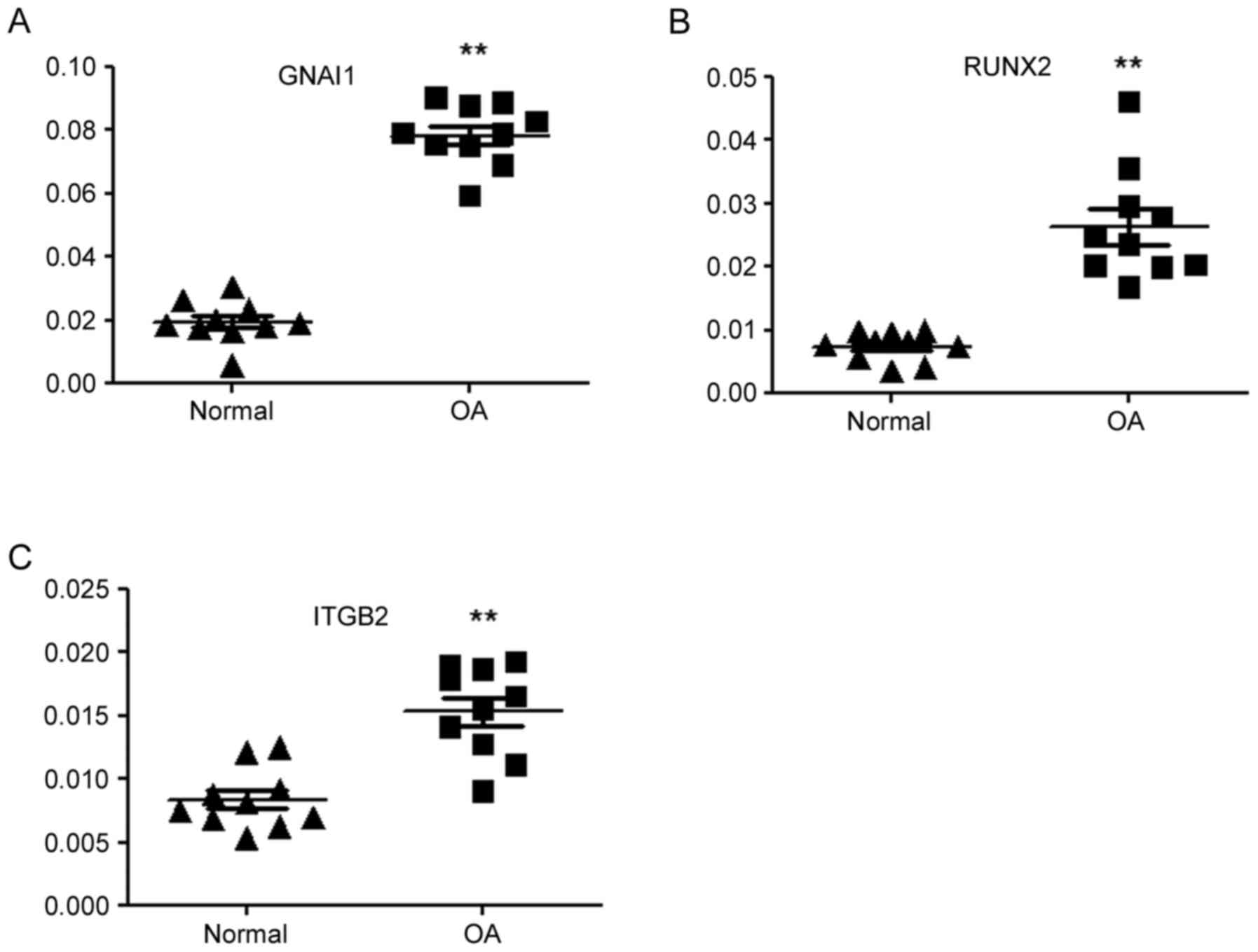Combined bioinformatics analysis reveals gene expression and DNA methylation patterns in osteoarthritis
- Authors:
- Published online on: April 12, 2018 https://doi.org/10.3892/mmr.2018.8874
- Pages: 8069-8078
-
Copyright: © Song et al. This is an open access article distributed under the terms of Creative Commons Attribution License.
Abstract
Introduction
Osteoarthritis (OA) is the most common type of arthritis and a leading cause of pain and disability, which places a great burden on the economy of health and reduces quality of life (1–3). OA involves the degeneration of numerous tissues, including subchondral bone, ligaments, muscle, tendons, and the meniscus and synovium (1). Numerous factors may affect OA progression, including age, gender, obesity, genetics and joint injury (4); however, how these factors affect the development of OA requires further investigation and no effective method has been developed for the relief of pain. In addition, molecular biology studies have identified numerous biomarkers and biological processes that contribute to OA, including the erosion of the extracellular matrix (5), the expression of chemokines (chemokine C-C ligands 9 and 5, and interleukin-8) (6) and the upregulation of inflammatory genes (7). Further investigation into the molecular events associated with cartilage degeneration is required.
Over the past decades, the development of high-throughput technologies has resulted in the large amount of accumulation of omics data for various complex diseases. For OA, gene expression profiling via microarray or high-throughput sequencing has become a promising method for the analysis of the mechanisms underlying its initiation and progression (8). For example, Rasheed et al (9) performed an integrated study of microRNA (miRNA) expression profiles in OA chondrocytes and OA-associated genes, and identified numerous miRNAs associated with the development of OA. Sun et al (10) reported several potential biomarkers for OA via differential expression and network analysis based on gene microarray datasets. Microarray analysis in the study of Loeser et al (11) indicated the link between age-associated differences in gene expression and the development of OA. In addition, epigenetic modifications serve important roles in gene expression regulation, and DNA methylation is one of the most common types of epigenetic modification. Recently, an increasing number of studies have focused on the associations between methylation status and the progression of OA (12,13). In contrast to cancer, in which CpG sites are frequently hypermethylated, the majority of studies investigating OA reported a higher frequency of hypomethylation (14,15). DNA methylation may also affect the allelic imbalance of specific small nucleotide polymorphisms, and thus the development of OA (16). Combined analysis of gene expression and DNA methylation profiles may contribute to the screening of potential biomarkers of OA, early diagnosis and treatment; to the best of our knowledge, an investigation into this is yet to be performed.
In the present study, combined analysis of publicly accessible gene expression and DNA methylation microarray datasets of OA was conducted. Functional enrichment and network analysis was performed for the identification of potential biomarkers. Numerous known and novel targets were obtained and their involvement in OA was further confirmed via reverse transcription-quantitative polymerase chain reaction (RT-qPCR) analysis.
Materials and methods
Microarray datasets
The publicly accessible data were all obtained from the Gene Expression Omnibus (GEO, www.ncbi.nlm.nih.gov/geo). Gene expression profiles deposited by Klinger et al (17), accession no. GSE43923, containing six samples (three osteophytic cartilage and three corresponding articular cartilage samples from the knee joints of patients with OA) were employed in the present study. The genome-wide expression profiles were quantified using the commercial gene microarray GPL570 [HG-U133_Plus_2] Affymetrix Human Genome U133 Plus 2.0 Array (Affymetrix; Thermo Fisher Scientific, Inc., Waltham, MA, USA). The DNA methylation profiles (GSE73626) (18) of five hip OA, six knee OA and seven hip healthy cartilage samples were detected via Illumina HumanMethylation450 BeadChip assay (Illumina, Inc., San Diego, CA, USA), which contains >480,000 methylation sites, covering 99% of RefSeq (https://www.ncbi.nlm.nih.gov/refseq/) genes and 96% of University of California, Santa Cruz (http://genome.ucsc.edu/)-defined CpG sites with an average of 17 CpG sites/gene across different genomic regions, including the promoter, 5′ untranslated region (UTR), first exon, gene body, intergenic and 3′UTR.
Microarray data analysis
The present study conducted differential expression analysis for osteophytic and articular cartilage samples from patients with OA. The raw CEL data were imported into R version 3.2.2 (http://www.R-project.org/) and normalized via the affy package (19); subsequently, the limma package (20) was used for the screening of differentially expressed genes (DEGs) with the criteria of fold change >1.5 and false discovery rate (FDR)<0.05. For the methylation dataset, site-level analysis was performed based on the Illumina Methylation Analyzer package (Illumina, Inc.) (21) to obtain the differentially methylated CpG sites (DMSs) between hip/knee OA cartilage and healthy cartilage samples, with thresholds of db value >0.2 and FDR<0.05. DMSs were mapped to the corresponding genes (DMGs) and genomic regions based on the full annotation file of the microarray and following this, cross analysis was performed via the ‘intersect’ function of R version 3.2.2 (http://www.R-project.org/) using DEGs and DMGs to reveal overlapping genes. In addition, differences between distributions of DMSs relative to CpG islands and genes were compared using the χ2 test.
Functional clustering analysis
Investigation into the functions of enriched DEGs and DMGs may improve understanding of their involvement in OA. In the present study, functional clustering analysis of DEGs and DMGs based on the Database for Annotation, Visualization and Integrated Discovery (DAVID; david.abcc.ncifcrf.gov) (22) was conducted. Clusters with an enrichment score >1, and Gene Ontology (GO) terms and Kyoto Encyclopedia of Genes and Genomes (KEGG; www.genome.jp/kegg) pathways with P<0.05 were retained in the present study.
Protein-protein interaction network analysis
Genes are likely to function together rather than alone in complex diseases; hub nodes in the network may represent key biomarkers. In the present study, protein-protein interaction (PPI) network analysis was performed to investigate the overlaps between DEGs and DMGs based on the Human Protein Reference Database (HPRD; www.hprd.org) (23). The network was visualized using Cytoscape 3.6.0 software (http://www.cytoscape.org/), and the topological property of every gene [degree (number of direct interactions in the network)] was additionally analyzed for the assessment of their importance.
RT-qPCR
Normal and OA tissues were obtained from the articular cartilage of 26 females and 20 males with a median age of 56.35 years (43.58–69.12 years) between April 2012 and April 2015 in Zibo Central Hospital (Zibo, China). Patients exhibiting temporomandibular joint pain that were not suffering from any form of rheumatic disease or cancer were included in the present study. The study was approved by the ethics committee of Zibo Central Hospital. Written informed consent was obtained from all patients.
Total RNA was extracted from OA and normal tissues (50–100 mg) using an RNeasy Mini kit (Qiagen GmbH, Hilden, Germany) and quantified with a NanoDrop system (Thermo Fisher Scientific, Inc.), and subsequently subjected to RT-qPCR using EasyScript Reverse Transcriptase kit (Promega Corporation, Madison, WI, USA). The temperature protocol used for RT was as follows: 95°C for 10 min, 55°C for 1 min and 68°C for 10 min.
The 7500 Real-Time PCR system (Applied Biosystems; Thermo Fisher Scientific, Inc.) was used for qPCR. Reactions were conducted in triplicate in each reaction tube using AceQ qPCR SYBR Green Master Mix (Vazyme Biotech Co., Ltd., Nanjing, China). The temperature protocol used for qPCR was as follows: 94°C for 5 min; followed by 40 cycles of 95°C for 10 sec and 60°C for 30 sec; followed by 95°C for 15 sec, 60°C for 60 sec and 95°C for 15 sec. Data were analyzed via the 2−ΔΔCq method using GAPDH as internal control (24). Primer sequences were: G protein subunit α1 (GNAI1) forward, 5′-TTAGGGCTATGGGGAGGTTGA-3′, and reverse, 5′-GGTACTCTCGGGATCTGTTGAAA-3′; runt related transcription factor 2 (RUNX2) forward, 5′-TGGTTACTGTCATGGCGGGTA-3′ and reverse, 5′-TCTCAGATCGTTGAACCTTGCTA-3′; integrin subunit β2 (ITGB2) forward, 5′-TGCGTCCTCTCTCAGGAGTG-3′ and reverse, 5′-GGTCCATGATGTCGTCAGCC-3′; and GAPDH forward, 5′-ACAACTTTGGTATCGTGGAAGG-3′ and reverse, 5′-GCCATCACGCCACAGTTTC-3′.
Statistical analysis
R version 3.2.2 (http://www.R-project.org/) was used for all of the statistical analysis. The relative mRNA expression levels in the RT-qPCR analysis were presented as the mean ± standard deviation of the three replicates. RT-qPCR data were analyzed using a Student's t-test. P<0.05 was considered to indicate a statistically significant difference.
Results
Gene expression profile analysis
The raw microarray data was normalized and used for the following differential expression analysis. As a result, a total of 466 genes were detected to be DEGs in osteophytic cartilage samples compared with articular samples, which contained 49 downregulated and 417 upregulated genes (Fig. 1A). The two-way supervised clustering indicated notable differences between osteophytic and articular cartilage samples from patients with OA, with blue and red coloring indicating low and high expression levels, respectively (Fig. 1B). The full list of DEGs is provided in Table I.
Table I.Previously identified biomarkers of osteoarthritis with the PMID of each corresponding reference. |
DMSs
Comparisons were performed between DMSs in hip/knee cartilage samples and healthy cartilage samples. As presented in Fig. 2A, the β values of OA hip compared with healthy hip tissue, and OA knee compared with healthy knee tissue, of all CpG sites in the microarray were obtained. The β values for OA hip compared with healthy hip tissue, and OA knee compared with healthy knee tissue, of CpG sites satisfied the criterion of P<0.05; the frequencies of hypomethylated sites were increased compared with hypermethylated sites in OA hip and knee samples (Fig. 2B). Additionally, the number of hypomethylated sites with P<0.05 and db>0.2 were increased compared with hypermethylated sites (Fig. 2C). This was consistent with the results of the DEG analysis (the number of upregulated genes was increased compared with downregulated genes), as hypermethylation of the promoter may result in the downregulation of the corresponding gene.
To improve understanding of the functional significance of DMSs, the functional locations of DMSs were investigated. As presented in Fig. 3A, the majority of the DMSs were reported to be in intergenic, gene body and promoter regions. Additionally, four neighborhood locations were defined in the Illumina HumanMethylation450 BeadChip assay: 31% CpG islands, 23% shores (0–2 kb from canonical CpG islands), 10% shelves (2–4 kb from canonical) and open sea (rest of the sequence). Consistent with the BeadChip assay, the majority of the hypo- and hypermethylated sites in hip and knee cartilage samples were detected in open sea, and following the north and south shores (upstream and downstream shores). To investigate the associations between functional and neighborhood locations with differential methylation status, a χ2 test for data presented in Fig. 3. The results indicated P<5×10−7 in all of the cases, demonstrating that functional and neighborhood locations are associated with differential methylation status. One-way clustering of DMSs of hip and knee cartilage samples is presented in Fig. 4.
Functional clusters
Functional clustering analysis in DAVID resulted in three functional clusters for DEGs and DMGs. DEGs were primarily involved in the GO terms and KEGG pathways that were associated with ‘cell structure’, ‘inflammatory and immune response’, ‘substance synthetic’ and ‘metabolic’. ‘Guanosine 5′-triphosphaate (GTP)ase activity’, ‘gene expression regulation’ and ‘inflammatory and immune response’ were reported to be significantly enriched in DMGs (data not shown).
Network analysis
Network topological properties are important representations of their roles in specific biological processes and diseases. In the present study, 30 overlaps were obtained among DMGs of hip and knee cartilage samples and DEGs; 20 of these overlaps were reported to interact with other genes from the HPRD. PPI networks are presented in Fig. 5. GNAI1 directly interacted with 50 genes, which was markedly higher compared with the degree of the other 19 overlaps in the network, potentially indicating its important roles in the development of OA. Table I includes the five previously identified biomarkers of OA and their corresponding PMID nos.
RT-qPCR analysis
A total of three hub genes, GNAI1, RUNX2 and integrin subunit β 2 (ITGB2), were subjected to RT-qPCR analysis for the quantification of their relative abundance in OA and control samples. The results of the RT-qPCR analysis were consistent with the results of the gene microarray analysis; the relative mRNA expression levels of GNAI1, RUNX2 and ITGB2 in OA samples were significantly increased compared with the control samples (Fig. 6).
Discussion
OA is the most common degenerative disease of the synovial membrane, comprising the destruction and loss of articular tissues (25). The initiation and development of OA have been reported to be associated with numerous factors, including age, joint injury, obesity and chronic inflammation, in addition to genetic factors, including epigenetic modification and altered gene or miRNA expression (26). In-depth understanding of gene regulation in OA may contribute to diagnosis and treatment. For this purpose, DNA methylation and gene expression analysis of hip and knee cartilage of OA patients was performed, and potential targets for OA were identified and verified in the present study.
DNA methylation has been revealed to repress gene expression by blocking the sites at the promoter where transcription factors bind; hypermethylation of the promoter is associated with no or low transcription (27). In the present study, the majority of the DEGs were observed to be upregulated and DMSs were hypomethylated, consistent with the roles of DNA methylation. Unlike cancer, which is characterized by the hypermethylation of tumor suppressor genes, genome-wide hypomethylation in OA has been widely observed previously (28–30) and in the present study. It is known that OA is influenced by inflammatory chemokines (31), which was also demonstrated by the functional enrichment analysis of the present study. The hypomethylation and increased expression of a number of inflammation-associated genes have been observed to be associated with OA, including IL-8 (32), nuclear factor-κB (33) and pleckstrin (34), which may serve as therapeutic targets for OA. In the present study, numerous genes that were differentially expressed and methylated simultaneously were identified, including ITGB2, GNAI1 and RUNX2. To the best of our knowledge, the roles of the aforementioned genes in the development of OA have not been investigated; the RT-qPCR analysis conducted in the present study revealed their relative abundance in OA and adjacent tissues, which may indicate their association with the progression of OA. Furthermore, numerous genes were observed to directly interact with other genes in the PPI network, including RUNX2, bleomycin hydrolase and gremlin 1 DAN family BMP antagonist (GREM1). The majority of these genes have been demonstrated to be closely associated with the progression of OA; for example, RUNX2 polymorphisms may affect temporomandibular joint OA in females (35) and may influence the expression of other genes in OA (36). The mRNA expression levels of GREM1 are correlated with OA and may be regulated by OA-associated factors (37); in addition, GREM1 is a key regulator of synoviocyte hyperplasia and invasiveness (38). Valverde-Franco et al (39) reported that ephrin-B2 may be essential for normal bone growth, and its absence may lead to knee and hip OA. In addition, a number of genes with a high degree in the PPI network have not been proven to be associated with the development of OA. For example, GNAI1, also known as Gi, is a protein that can hydrolyze GTP and interact with other proteins, and T cell differentiation may alter its structure (40). Additionally, the altered expression of GNAI1 was observed to be associated with the progression of inflammatory and immune diseases (41,42), and may be considered to be a novel biomarker for OA.
Certain limitations of the present study were noted. Only three genes were analyzed via RT-qPCR and future studies are required to investigate more genes. Furthermore, osteophytes may be considered to contribute to regeneration in OA joints; however, further studies investigating the differences regarding whole genome expression between OA and healthy tissues should be employed for further analysis in the present study.
In conclusion, the present study provided a pipeline for the combined analysis of gene expression and DNA methylation datasets. In addition, numerous known and potential novel markers were proposed in the present study, which may contribute to diagnosis and treatment targets for OA; however, further investigation is required for confirmation of the functions exhibited by these markers.
Acknowledgements
Not applicable.
Funding
No funding was received.
Availability of data and materials
The datasets analyzed in the present study are available in the GEO repository, www.ncbi.nlm.nih.gov/geo/query/acc.cgi?acc=GSE43923 and www.ncbi.nlm.nih.gov/geo/query/acc.cgi?acc=GSE73626.
Authors' contributions
DS analyzed and interpreted the microarray datasets and produced the manuscript. WQ and ML modified the syntax; CY and KT designed experiments of the present study. FZ made substantial contributions to the conception and design of the study, and submitted the manuscript. All authors read and approved the final manuscript.
Ethics approval and consent to participate
The present study was approved by the ethics committee of Zibo Central Hospital, Zibo, China. Written informed consent was obtained from all patients.
Consent for publication
Not applicable.
Competing interests
The authors declare that they have no competing interests.
References
|
Pan Q, O'Connor MI, Coutts RD, Hyzy SL, Olivares-Navarrete R, Schwartz Z and Boyan BD: Characterization of osteoarthritic human knees indicates potential sex differences. Biol Sex Differ. 7:272016. View Article : Google Scholar : PubMed/NCBI | |
|
Young IC, Chuang ST, Hsu CH, Sun YJ, Liu HC, Chen YS and Lin FH: Protective effects of aucubin on osteoarthritic chondrocyte model induced by hydrogen peroxide and mechanical stimulus. BMC Complement Altern Med. 17:912017. View Article : Google Scholar : PubMed/NCBI | |
|
Rhee J, Park SH, Kim SK, Kim JH, Ha CW, Chun CH and Chun JS: Inhibition of BATF/JUN transcriptional activity protects against osteoarthritic cartilage destruction. Ann Rheum Dis. 76:427–434. 2017. View Article : Google Scholar : PubMed/NCBI | |
|
Zhang M, Egan B and Wang J: Epigenetic mechanisms underlying the aberrant catabolic and anabolic activities of osteoarthritic chondrocytes. Int J Biochem Cell Biol. 67:101–109. 2015. View Article : Google Scholar : PubMed/NCBI | |
|
Schwager J, Hoeller U, Wolfram S and Richard N: Rose hip and its constituent galactolipids confer cartilage protection by modulating cytokine, and chemokine expression. BMC Complement Altern Med. 11:1052011. View Article : Google Scholar : PubMed/NCBI | |
|
Nair A, Gan J, Bush-Joseph C, Verma N, Tetreault MW, Saha K, Margulis A, Fogg L and Scanzello CR: Synovial chemokine expression and relationship with knee symptoms in patients with meniscal tears. Osteoarthritis Cartilage. 23:1158–1164. 2015. View Article : Google Scholar : PubMed/NCBI | |
|
Hashimoto S, Rai MF, Gill CS, Zhang Z, Sandell LJ and Clohisy JC: Molecular characterization of articular cartilage from young adults with femoroacetabular impingement. J Bone Joint Surg Am. 95:1457–1464. 2013. View Article : Google Scholar : PubMed/NCBI | |
|
Park R and Ji JD: Unique gene expression profile in osteoarthritis synovium compared with cartilage: Analysis of publicly accessible microarray datasets. Rheumatol Int. 36:819–827. 2016. View Article : Google Scholar : PubMed/NCBI | |
|
Rasheed Z, Al-Shobaili HA, Rasheed N, Al Salloom AA, Al-Shaya O, Mahmood A, Alajez NM, Alghamdi AS and Mehana el-SE: Integrated study of globally expressed micrornas in il-1beta-stimulated human osteoarthritis chondrocytes and osteoarthritis relevant genes: A microarray and bioinformatics analysis. Nucleosides Nucleotides Nucleic Acids. 35:335–355. 2016. View Article : Google Scholar : PubMed/NCBI | |
|
Sun J, Yan B, Yin W and Zhang X: Identification of genes associated with osteoarthritis by microarray analysis. Mol Med Rep. 12:5211–5216. 2015. View Article : Google Scholar : PubMed/NCBI | |
|
Loeser RF, Olex AL, McNulty MA, Carlson CS, Callahan MF, Ferguson CM, Chou J, Leng X and Fetrow JS: Microarray analysis reveals age-related differences in gene expression during the development of osteoarthritis in mice. Arthritis Rheum. 64:705–717. 2012. View Article : Google Scholar : PubMed/NCBI | |
|
Housman G, Havill LM, Quillen EE, Comuzzie AG and Stone AC: Assessment of DNA methylation patterns in the bone and cartilage of a nonhuman primate model of osteoarthritis. Cartilage. 1:19476035187591732018. | |
|
Peffers M, Balaskas P and Smagul A: Osteoarthritis year in review 2017: Genetics and epigenetics. Osteoarthritis Cartilage. 26:304–311. 2018. View Article : Google Scholar : PubMed/NCBI | |
|
Zhang Y, Fukui N, Yahata M, Katsuragawa Y, Tashiro T, Ikegawa S and Lee MT: Genome-wide DNA methylation profile implicates potential cartilage regeneration at the late stage of knee osteoarthritis. Osteoarthritis Cartilage. 24:835–843. 2016. View Article : Google Scholar : PubMed/NCBI | |
|
Rushton MD, Young DA, Loughlin J and Reynard LN: Differential DNA methylation and expression of inflammatory and zinc transporter genes defines subgroups of osteoarthritic hip patients. Ann Rheum Dis. 74:1778–1782. 2015. View Article : Google Scholar : PubMed/NCBI | |
|
Reynard LN, Bui C, Syddall CM and Loughlin J: CpG methylation regulates allelic expression of GDF5 by modulating binding of SP1 and SP3 repressor proteins to the osteoarthritis susceptibility SNP rs143383. Hum Genet. 133:1059–1073. 2014. View Article : Google Scholar : PubMed/NCBI | |
|
Klinger P, Beyer C, Ekici AB, Carl HD, Schett G, Swoboda B, Hennig FF and Gelse K: The transient chondrocyte phenotype in human osteophytic cartilage: A role of pigment epithelium-derived factor? Cartilage. 4:249–255. 2013. View Article : Google Scholar : PubMed/NCBI | |
|
Aref-Eshghi E, Zhang Y, Liu M, Harper PE, Martin G, Furey A, Green R, Sun G, Rahman P and Zhai G: Genome-wide DNA methylation study of hip and knee cartilage reveals embryonic organ and skeletal system morphogenesis as major pathways involved in osteoarthritis. BMC Musculoskelet Disord. 16:2872015. View Article : Google Scholar : PubMed/NCBI | |
|
Gautier L, Cope L, Bolstad BM and Irizarry RA: Affy-analysis of affymetrix genechip data at the probe level. Bioinformatics. 20:307–315. 2004. View Article : Google Scholar : PubMed/NCBI | |
|
Diboun I, Wernisch L, Orengo CA and Koltzenburg M: Microarray analysis after RNA amplification can detect pronounced differences in gene expression using limma. BMC Genomics. 7:2522006. View Article : Google Scholar : PubMed/NCBI | |
|
Wang D, Yan L, Hu Q, Sucheston LE, Higgins MJ, Ambrosone CB, Johnson CS, Smiraglia DJ and Liu S: IMA: An R package for high-throughput analysis of Illumina's 450K Infinium methylation data. Bioinformatics. 28:729–730. 2012. View Article : Google Scholar : PubMed/NCBI | |
|
Dennis G Jr, Sherman BT, Hosack DA, Yang J, Gao W, Lane HC and Lempicki RA: DAVID: Database for annotation, visualization, and integrated discovery. Genome Biol. 4:P32003. View Article : Google Scholar : PubMed/NCBI | |
|
Prasad Keshava TS, Goel R, Kandasamy K, Keerthikumar S, Kumar S, Mathivanan S, Telikicherla D, Raju R, Shafreen B, Venugopal A, et al: Human protein reference database-2009 update. Nucleic Acids Res. 37:D767–D772. 2009. View Article : Google Scholar : PubMed/NCBI | |
|
Livak KJ and Schmittgen TD: Analysis of relative gene expression data using real-time quantitative PCR and the 2 (-Delta Delta C(T)) method. Methods. 25:402–408. 2001. View Article : Google Scholar : PubMed/NCBI | |
|
Yang F, Zhou S, Wang C, Huang Y, Li H, Wang Y, Zhu Z, Tang J and Yan M: Epigenetic modifications of interleukin-6 in synovial fibroblasts from osteoarthritis patients. Sci Rep. 7:435922017. View Article : Google Scholar : PubMed/NCBI | |
|
Zhou X, Chen L, Grad S, Alini M, Pan H, Yang D, Zhen W, Li Z, Huang S and Peng S: The roles and perspectives of microRNAs as biomarkers for intervertebral disc degeneration. J Tissue Eng Regen Med. 11:3481–3487. 2017. View Article : Google Scholar : PubMed/NCBI | |
|
Suzuki MM and Bird A: DNA methylation landscapes: Provocative insights from epigenomics. Nat Rev Genet. 9:465–476. 2008. View Article : Google Scholar : PubMed/NCBI | |
|
Yang J and Wang N: Genome-wide expression and methylation profiles reveal candidate genes and biological processes underlying synovial inflammatory tissue of patients with osteoarthritis. Int J Rheum Dis. 18:783–790. 2015. View Article : Google Scholar : PubMed/NCBI | |
|
Johnson AA, Akman K, Calimport SR, Wuttke D, Stolzing A and de Magalhaes JP: The role of DNA methylation in aging, rejuvenation, and age-related disease. Rejuvenation Res. 15:483–494. 2012. View Article : Google Scholar : PubMed/NCBI | |
|
Ezura Y, Sekiya I, Koga H, Muneta T and Noda M: Methylation status of CpG islands in the promoter regions of signature genes during chondrogenesis of human synovium-derived mesenchymal stem cells. Arthritis Rheum. 60:1416–1426. 2009. View Article : Google Scholar : PubMed/NCBI | |
|
Rogers EL, Reynard LN and Loughlin J: The role of inflammation-related genes in osteoarthritis. Osteoarthritis Cartilage. 23:1933–1938. 2015. View Article : Google Scholar : PubMed/NCBI | |
|
Takahashi A, de Andres MC, Hashimoto K, Itoi E and Oreffo RO: Epigenetic regulation of interleukin-8, an inflammatory chemokine, in osteoarthritis. Osteoarthritis Cartilage. 23:1946–1954. 2015. View Article : Google Scholar : PubMed/NCBI | |
|
Imagawa K, de Andrés MC, Hashimoto K, Pitt D, Itoi E, Goldring MB, Roach HI and Oreffo RO: The epigenetic effect of glucosamine and a nuclear factor-kappa B (NF-κB) inhibitor on primary human chondrocytes-implications for osteoarthritis. Biochem Biophys Res Commun. 405:362–367. 2011. View Article : Google Scholar : PubMed/NCBI | |
|
Fernández-Tajes J, Soto-Hermida A, Vázquez-Mosquera ME, Cortés-Pereira E, Mosquera A, Fernández-Moreno M, Oreiro N, Fernández-López C, Fernández JL, Rego-Pérez I and Blanco FJ: Genome-wide DNA methylation analysis of articular chondrocytes reveals a cluster of osteoarthritic patients. Ann Rheum Dis. 73:668–677. 2014. View Article : Google Scholar : PubMed/NCBI | |
|
Xiao JL, Meng JH, Gan YH, Zhou CY and Ma XC: Association of GDF5, SMAD3 and RUNX2 polymorphisms with temporomandibular joint osteoarthritis in female Han Chinese. J Oral Rehabil. 42:529–536. 2015. View Article : Google Scholar : PubMed/NCBI | |
|
Ji Q, Xu X, Xu Y, Fan Z, Kang L, Li L, Liang Y, Guo J, Hong T, Li Z, et al: miR-105/Runx2 axis mediates FGF2-induced ADAMTS expression in osteoarthritis cartilage. J Mol Med (Berl). 94:681–694. 2016. View Article : Google Scholar : PubMed/NCBI | |
|
Leijten JC, Bos SD, Landman EB, Georgi N, Jahr H, Meulenbelt I, Post JN, van Blitterswijk CA and Karperien M: GREM1, FRZB and DKK1 mRNA levels correlate with osteoarthritis and are regulated by osteoarthritis-associated factors. Arthritis Res Ther. 15:R1262013. View Article : Google Scholar : PubMed/NCBI | |
|
Han EJ, Yoo SA, Kim GM, Hwang D, Cho CS, You S and Kim WU: GREM1 is a key regulator of synoviocyte hyperplasia and invasiveness. J Rheumatol. 43:474–485. 2016. View Article : Google Scholar : PubMed/NCBI | |
|
Valverde-Franco G, Lussier B, Hum D, Wu J, Hamadjida A, Dancause N, Fahmi H, Kapoor M, Pelletier JP and Martel-Pelletier J: Cartilage-specific deletion of ephrin-B2 in mice results in early developmental defects and an osteoarthritis-like phenotype during aging in vivo. Arthritis Res Ther. 18:652016. View Article : Google Scholar : PubMed/NCBI | |
|
Kaya AI, Lokits AD, Gilbert JA, Iverson TM, Meiler J and Hamm HE: A conserved hydrophobic core in Gαi1 regulates G protein activation and release from activated receptor. J Biol Chem. 291:19674–19686. 2016. View Article : Google Scholar : PubMed/NCBI | |
|
Diehl SA, McElvany B, Noubade R, Seeberger N, Harding B, Spach K and Teuscher C: G proteins galphai1/3 are critical targets for bordetella pertussis toxin-induced vasoactive amine sensitization. Infect Immun. 82:773–782. 2014. View Article : Google Scholar : PubMed/NCBI | |
|
Rivetti S, Lauriola M, Voltattorni M, Bianchini M, Martini D, Ceccarelli C, Palmieri A, Mattei G, Franchi M, Ugolini G, et al: Gene expression profile of human colon cancer cells treated with cross-reacting material 197, a diphtheria toxin non-toxic mutant. Int J Immunopathol Pharmacol. 24:639–649. 2011. View Article : Google Scholar : PubMed/NCBI | |
|
Mabey T, Honsawek S, Saetan N, Poovorawan Y, Tanavalee A and Yuktanandana P: Angiogenic cytokine expression profiles in plasma and synovial fluid of primary knee osteoarthritis. Int Orthop. 38:1885–1892. 2014. View Article : Google Scholar : PubMed/NCBI | |
|
Gao W, Sweeney C, Walsh C, Rooney P, McCormick J, Veale DJ and Fearon U: Notch signalling pathways mediate synovial angiogenesis in response to vascular endothelial growth factor and angiopoietin 2. Ann Rheum Dis. 72:1080–1088. 2013. View Article : Google Scholar : PubMed/NCBI | |
|
Yi J, Jin Q, Zhang B, Wu X and Ge D: Gremlin-1 concentrations are correlated with the severity of knee osteoarthritis. Med Sci Monit. 22:4062–4065. 2016. View Article : Google Scholar : PubMed/NCBI | |
|
Fan Y, Chen J, Yang Y, Lin J and Wu Z: Genome-wide expression and methylation profiling reveal candidate genes in osteoarthritis. Clin Exp Rheumatol. 35:983–990. 2017.PubMed/NCBI | |
|
Hopwood B, Tsykin A, Findlay DM and Fazzalari NL: Microarray gene expression profiling of osteoarthritic bone suggests altered bone remodelling, WNT and transforming growth factor-β/bone morphogenic protein signalling. Arthritis Res Ther. 9:R1002007. View Article : Google Scholar : PubMed/NCBI | |
|
Liao L, Zhang S, Gu J, Takarada T, Yoneda Y, Huang J, Zhao L, Oh CD, Li J, Wang B, et al: Deletion of Runx2 in articular chondrocytes decelerates the progression of DMM-induced osteoarthritis in adult mice. Sci Rep. 7:23712017. View Article : Google Scholar : PubMed/NCBI |



